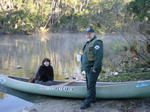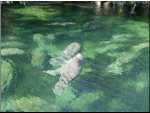 |
 |
 |
 |
 |
 |
 |
Manatee Migration Update: February 20, 2002
Today's Report Includes:
- Ranger Wayne's World
- Field Notes from Blue Spring State Park
- Raise Your Flipper When Your Name is Called: CQ #4
- Hungry for Geography? Make an Edible Map
- One Day They're Here, The Next Day They're Gone: CQ #5
- Welcome Airborne Ackerman
- Field Notes From Dr. Ackerman: CQ #6
- Latest Satellite Data and Maps
- Latest Field Notes From Cathy Beck: CQ #7
- Discussion of CQ's #1, 2 and 3
- Manatee Ask the Expert Now Open!
- Coming in the Next Reports
Ranger Wayne's World
|
|
In this report, you'll dive into Ranger Wayne's manatee "Roll Call"
data, which you'll need to know about when he asks you to get in the canoe! You'll
also get a "taste" of what it's like at Blue Spring.
Field Notes from Blue Spring State Park
|
|
|
Blue Spring State Park |
|
|
My day began early in the morning, before the usual crowds of people flock to see manatees from viewing platforms on the banks of the Blue Spring "Run". The Run is like a wide stream that "runs" from inside the Park down to the St. Johns River, a distance of about 1/3 mile. The morning air temperature was around 41 degrees F ( 5 degrees C), just one degree warmer than when I left unseasonably warm Minnesota(44.96,-93.54)! But of course Florida in winter is much different than Minnesota in winter. Instead of snow and pale colors, Blue Spring was green and lush with spanish moss hanging from every tree.
|
|
|
|
How does Ranger Waybe know who's who? How can he tell them apart? Has he ever "met" an alligator? I experienced so much at Blue Spring, and there's much more to explore--stay tuned.
Raise Your Flipper When Your Name is Called
|
|
Take a look at some of Ranger Wayne's Attendance Sheets, then, see if you can answer
Challenge Question #4:
A) "December 23: How many manatees were counted between transect 1 and 2?"
B) "December 31: If Ranger Wayne didn't see a manatee in transect 16 & 18, how did he know they had been there?"
C) "January 15: What did Ranger Wayne record seeing in transect 13? Why could that be a serious problem for manatees?"
D) "February 8: Who is Manatee #234, and what did he have yesterday evening?"
|
|
|
|
|
|
|
Blank Attendance Form |
December 23 |
December 31 |
January 15 |
February 8 |
(To respond to this question, please follow the instructions below.)
Try This! Hungry for Geography? Make an Edible Map
To really get a detailed understanding of the layout of the Run at Blue Spring, make this edible Map. You'll get your hands, eyes and teeth into this project:
One Day They're Here, The Next Day They're Gone
Ranger Wayne's Attendance Sheets show that the number of manatees can vary from day to day, from none to ninety. What might explain the changing numbers of manatees that Ranger Wayne counts? A table of Ranger Wayne's data from his Attendance Sheets is below.
Challenge Question # 5:
"Can you see any patterns or trends in the data that explains the reason(s) for the changing number of manatees?"
|
Date |
Air Temp Low(C) |
Air Temp High(C) |
River Temp (C) |
Run Temp. (C) |
# of Manatees |
| 12/19 |
5.1 |
28.5 |
21.6 |
nt |
0 |
| 12/23 |
9.5 |
23.5 |
17.9 |
22.5 |
34 |
| 12/31 |
-1 |
24.0 |
15.1 |
22.5 |
73 |
| 01/05 |
-1.5 |
10 |
11.7 |
nt |
97 |
| 01/15 |
6 |
19 |
13.9 |
22.4 |
67 |
| 01/31 |
16.5 |
30 |
22.1 |
22.4 |
0 |
| 02/03 |
15 |
24 |
22.3 |
nt |
0 |
| 02/08 |
8 |
18 |
17.9 |
22.6 |
30 |
| 02/09 |
9 |
17 |
17.6 |
22.6 |
61 |
*(All temperatures are in degrees Celcius; "nt" = temperature not taken)
(To respond to this question, please follow the instructions below.)
Welcome Airborne Ackerman
We're thrilled that we also have manatee population expert Dr. Bruce Ackerman back again. Dr. Ackerman is a manatee biologist and population expert with the Florida Marine Research Institute. He has the far-reaching task of coordinating the State's annual aerial manatee census, which uses crews across the State of Florida in small planes, helicopters and ground crews to count the manatees at all the wintering sites on both coasts. But this year, the annual aerial census has not been able to take off!
Field Notes From Dr. Ackerman
|
|
A Rx for Aerial Surveys
In order to have an effective aerial census, we have a prescription (Rx) of weather conditions:
1) A prolonged cold front,
2) A significant drop in water temperature, and
3) A sunny and windless day following the cold front
Challenge Question #6:
"Why is this the perfect prescription for manatee surveys? Give reasons why you think each of the three weather factors might make counts higher."
(To respond
to this question, please follow the instructions below.)
We'll be watching to see if this long run of unusually warm weather will affect the
manatee population in other ways. I look forward to bringing you more news in the
next report.
Dr. Bruce B. Ackerman
Research Scientist
Florida
Marine Research Institute
Florida Fish and Wildlife
Conservation Commission
St. Petersburg FL 33701-5095
Latest Satellite Migration Data
|
|
|
Latest All Manatee Migration Map |
(Courtesy of U.S. Geological Survey's Sirenia Project)
- Data & Individual Map for Actual
- Data & Individual Map for Addison
- Data & Individual Map for Albert
- Data & Individual Map for Grace
- Data & Individual Map for Megan
- Data & Individual Map for PeggyLee
- Data & Individual Map for Santina
- Data Only for All Manatees--Printer-friendly Format
Latest Field Notes From Cathy Beck
Hello students! Last week it was Dean's turn to spend the week in the
field observing and tracking the manatees, and Dean related some interesting news.
|
|
Challenge Question #7:
"What do you think is attracting the manatees to the Cape Romano area?"
(To respond
to this question, please follow the instructions below.)
Dean also observed that as he slowly drove his boat, a few of our manatees wisely
moved away. Peggy Lee, who bears scars from several previous encounters with boats,
moved deliberately and skillfully to avoid Dean's boat; so did Santina. Many manatees
are not so lucky. Most manatees bear scars from being hit by boat motor propellers
and skegs. And power boat strikes are one of the leading causes of manatee mortality
each year.
Cathy Beck
Sirenia Project
Gainesville, FL
Capture Recap: Discussion of CQ#1
In our last report, we asked you to go back in time and "Compare the overall health of manatees captured this year to those captured in 2001" and describe the reasons for any differences from one year to the next.
New Jersey's Iselin Middle School students Nathaniel, Stephen L., Stephen M., and Alex looked into both years and "captured" the answer themselves.
"In 2001 the captured manatees were showing cold stress. In 2002 they were in good condition and seemed quite healthy. They were tagged and released. We think the reason for the difference is that the water was warmer this year." Ms. Eckstein, Grade 7, NJ
Cathy Beck confirmed the students' answer, noting "the captures were very
successful! Unlike last year when the manatees were showing the physical effects
of enduring a hard winter, all the manatees this year are in great condition!"
Measuring Manatee Movements: Discussion of CQ #2
By mapping the manatees' movements, you were able to uncover the answers to where and how far the manatees traveled between January 29 and February 1:
(a)"In what direction has each manatee traveled?"
The manatees moved in many different directions. Actual, Addison, Grace and Peggy Lee all moved northwest; Albert went southeast; and Megan went east while Santina headed west.
(b) "Which manatee had the greatest change in longitude? How many degrees of longitude did it travel between January 29 and February 1?"
(c) "Which manatee had the greatest change in latitude? How many degrees of latitude did it travel between January 29 and February 1? How many miles does that represent in total? As a daily average distance? "
As it turns out, Peggy Lee had the biggest change in both longitude (.192 degrees)
and latitude (.085 degrees). Her latitude change represents movement of about 5.84
miles, which divided by three days gives an average daily latitude distance change
of about 1.95 miles.
What's in a Date? Discussion of CQ #3
In this question we asked you about a different type of calendar: "What is the name of the standard calendar/date system we use in our daily lives? What is the name of the calendar/date system that ARGOS uses? (Hint: "Hail Caesar!") How would the ARGOS calendar/date system indicate the following dates?"
In our normal lives, we use the Gregorian calendar, which uses months and days of the month to track time. However, as Cathy Beck explained, the ARGOS satellite system uses a "Julian" calendar (named after Julius Caesar), which simply designates days by their chronological order in a year without regard to month. So the following Gregorian dates have the following Julian dates:
| Gregorian Date | Julian Date |
| (a) February 14, 2002 | Day 45 |
| (b) March 20, 2002 | Day 79 |
| (c) December 31, 2002 | Day 365 |
| (d) January 1, 2003 | Day 1 |
Manatee Ask the Expert Now Open!
We're lucky to have Nancy Sadusky back as our expert for her sixth year to answer your questions! Nancy is the Communications Director of Save the Manatee Club. Hurry, Nancy will accept your questions until March 1.
Coming in the Next Reports
- Where Will Your Manatees Travel? Get the Latest!
- Warm Weather Worries
- Ranger Wayne Wants You! (to Take the Roll Call)
- Dark and Deep Waters
- Manatee Adaptations
How to Respond to Today's Challenge Questions
IMPORTANT: Answer only ONE question in each e-mail message.
1. Address an E-mail message to: jn-challenge-manatee@learner.org
2. IMPORTANT: In the Subject
Line of your message write: Challenge Question #4(OR #5 OR #6 OR #7)
3. In the body of the EACH message, give your answer to ONE of the questions above.
The Next Manatee Migration Update will Be Posted on March 6, 2002
Copyright 2001 Journey North. All Rights Reserved.
Please send all questions, comments, and suggestions to our feedback form
|
|
|
|
|
|
|
|













